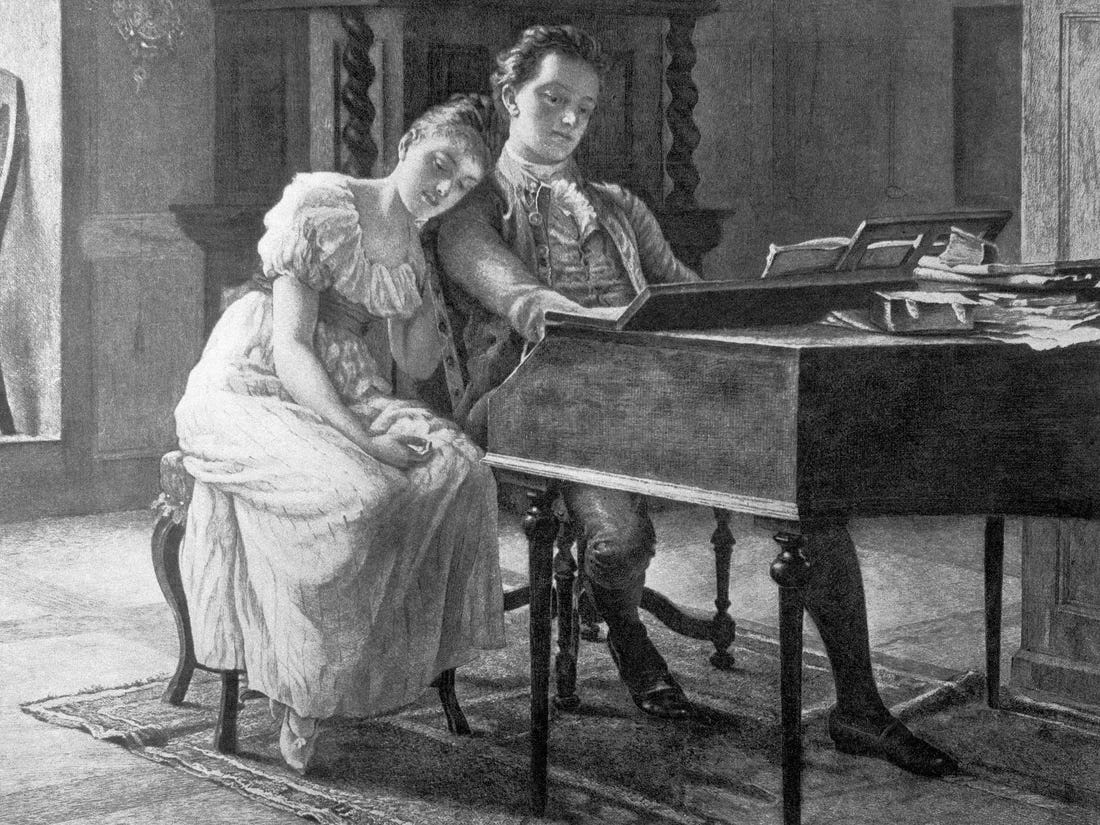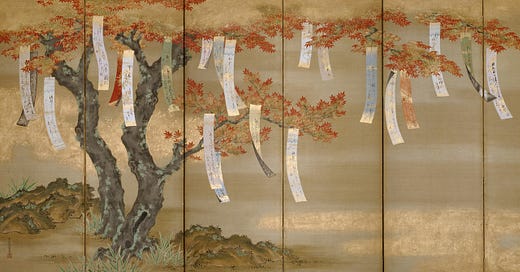Branching Out / Vol. 8
What to listen to next, based on our recent experiences with the music of Felix Mendelssohn and Frédéric Chopin.

Welcome to the eighth edition of Branching Out — where works recently featured in Shades of Blue become your launching point for discovering more melancholy music that cultivates calm, connection, and healing. (If you're a new subscriber, head over here to explore previous installments.)
To grow our tree of classical music knowledge this month, we'll explore music inspired by our recent experiences listening to the hushed hymn of romantic devotion in Felix Mendelssohn's Second String Quartet, and Frédéric Chopin's Mazurka in A Minor, a nostalgia-laced dance that transports us to a place of love and belonging.
So let's dig in and branch out …
If you swooned over the intimacy of Mendelssohn's string quartet and the ways it channels the rush of joy love ignites within us, then listen to …
Fanny Mendelssohn Hensel / String Quartet
Felix wasn't the only talented musician in the Mendelssohn household. His older sister Fanny was also an accomplished pianist, composer, and music director.
Although born three years apart, Felix and Fanny were raised like twins — studying music theory, composition, and piano with the same teacher, taking part in performances at the Berlin Singakademie, and supporting each other's progress every step of the way. Fanny referred to her brother as "my little Hamlet," and Felix called Fanny "my Minerva," his own goddess of wisdom who could alleviate all feelings of self-doubt.
"I've always been his only musical advisor," Fanny wrote in her diary, "and he never writes down a thought before I give him feedback."

Both siblings received the full support of their parents throughout their musical education, but given the time in which she lived, Fanny knew music could never be her professional vocation. As her father often reminded her, Fanny's role in life would be that of housewife and mother.
Thankfully the man she married in 1829, court painter Wilhelm Hensel, believed wholeheartedly in his wife's artistic abilities. Wilhelm championed her work producing and performing in Sunday-evening salons at the Mendelssohn family's home in Berlin, which were attended by members of the aristocracy and many of the biggest names in European music. He also encouraged her to begin publishing her compositions — nearly 450 works in total, including hundreds of art songs and piano pieces, several choral works, and a string quartet for two violins, viola, and cello.
Sadly, at the age of 41 — less than one year after publishing her first song collection — Fanny suffered a fatal stroke while rehearsing a choir for one of her Sunday salons. Felix was devastated by the news of his sister's death and never recovered from the loss. Just five months later, he too died, aged 38, and was buried next to his sister in the cemetery of Berlin's Holy Trinity Church.
It would take nearly 150 years for Fanny to receive the recognition she deserves as a composer. And now that her music appears more regularly on the concert stage and in recordings, we can hear the ways in which each sibling greatly influenced the other's work.
Fanny's sole string quartet offers the same delightful mix of puckish energy and lilting lyricism music lovers have come to know in Felix's music. But at the same time, her quartet displays an original voice of staggering imagination, particularly in the slow opening movement, where a moody journey of sighs and shadows ultimately finds gentle light and major-key resolution in its final, breathtaking moments.
Aris Quartett
(A tip of the hat to Shades of Blue reader
for introducing me to Fanny's quartet this summer.)If you were moved by the sense of blissful reverie and gentle longing Chopin embedded into his Mazurka in A Minor, be sure to spend some time with …
Frédéric Chopin / Cello Sonata
Given Frédéric's ability to spin shimmering melodies of exceptional beauty, it's a shame he hardly ever wrote solo music for orchestral instruments or the voice. In fact, out of his hundreds of works, only 11 involve instruments other than the piano — 10 of which feature the cello.
On an aesthetic level, Frédéric surely considered the cello's wide-ranging voice — from its gravelly depths to the magnificent heights of its tenor register — an ideal vehicle for his musical expression. But we can also attribute Frédéric's relative abundance of cello music to his close friendship with Auguste Franchomme, one of the finest cellists of his day.
Frédéric couldn't have asked for a better friend than Auguste. The pair spent summer holidays together in the French countryside, Auguste transcribed dozens of Frédéric's solo piano works for cello and piano, and he helped the Polish composer cultivate emotional strength during the lowest moments in his life. (While Frédéric mourned the death of his father in 1844, it wasn't his lover George Sand who comforted him, but Auguste.) Frédéric even referred to Auguste using the French language's familiar personal pronoun tu — a rare sign of affinity among his non-Polish friends.
As a tribute to their friendship, Frédéric composed his Cello Sonata in 1847, one of the final works he'd complete before his death two years later. Like his Mazurka in A Minor, Frédéric's final sonata teems with melancholy and nostalgia — especially in the slow movement, in which a melody of breathtaking simplicity blossoms into a musical meditation suffused with the echoes of a long-ago joy.
The pair premiered the sonata in what turned out to be Frédéric's final public performance, a concert his friends begged him to postpone due to illness, according to one confidante:
"On our arrival we found [Chopin] hardly able to move, bent like a half-opened pen knife, and evidently in great pain. … Soon he sat down to the piano, and as he warmed to his work, his body gradually resumed its normal position, the spirit having mastered the flesh."
Auguste's support never wavered. He was at Frédéric's side as a final bout with tuberculosis ravaged his body, and along with the artist Eugène Delacroix, he served as a pallbearer during the funeral procession to Paris's Père Lachaise Cemetery.
And in the months and years following Frédéric's death, Auguste worked to ensure his friend's legacy would not be forgotten. He not only coordinated the publication of many of the composer's final works and continued to perform his cello music, but Auguste's daughter, Cécile, studied piano with one of Frédéric's students — the first of countless generations of pianists who have helped keep the flame of Frédéric's music alive for nearly two centuries.
Camille Thomas, cello Julien Brocal, piano
I'd love to hear about your experiences listening to these works. Let me know — either by replying to this email or leaving a comment.
(And if you enjoyed your time here today, would you ever so kindly tap that little heart below? 👇🏼)
Thank you for reading Shades of Blue!
This newsletter is free, but paid subscribers help support the 20+ hours of research, writing, editing, and production that goes into every essay. If you look forward to reading Shades of Blue when it arrives in your inbox, please consider becoming a paid subscriber …
Or if you'd prefer to buy me a coffee as a token of thanks for this article, you can make a one-time donation to support this newsletter:






Two very beautiful selections. Thank you!
And popping back over to this piece to ask you if (amidst the moving hijinks) you saw NYT’s The Morning feature on the Chopin Waltz discovery!! Incredible!!!
https://www.nytimes.com/2024/10/27/arts/music/chopin-waltz-discovery.html